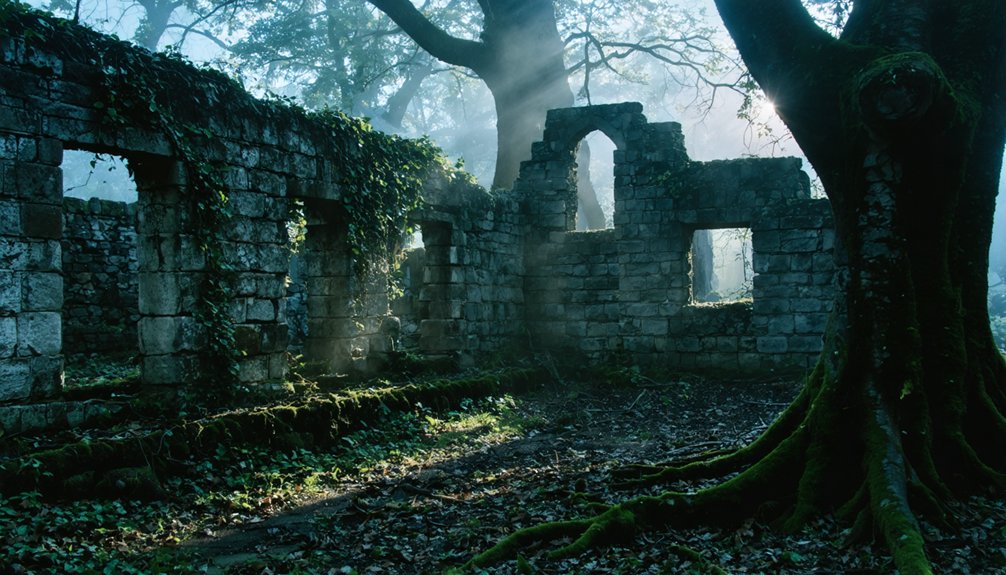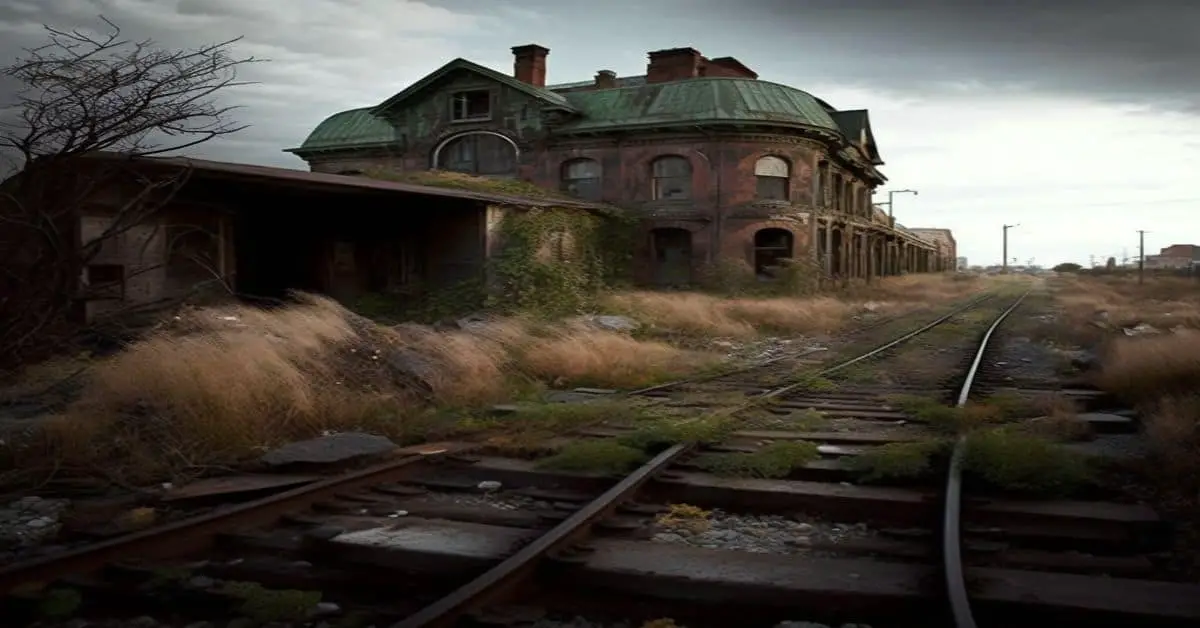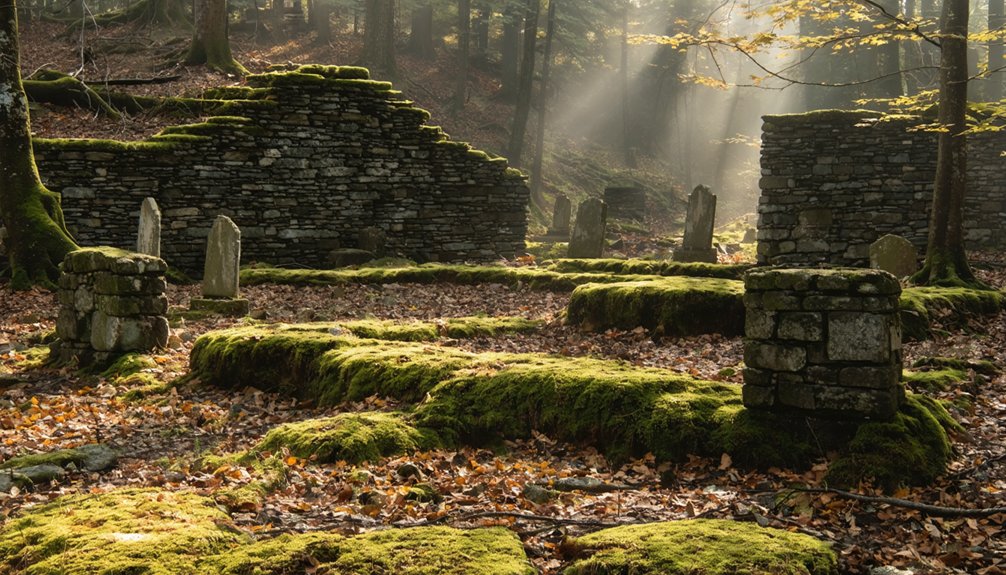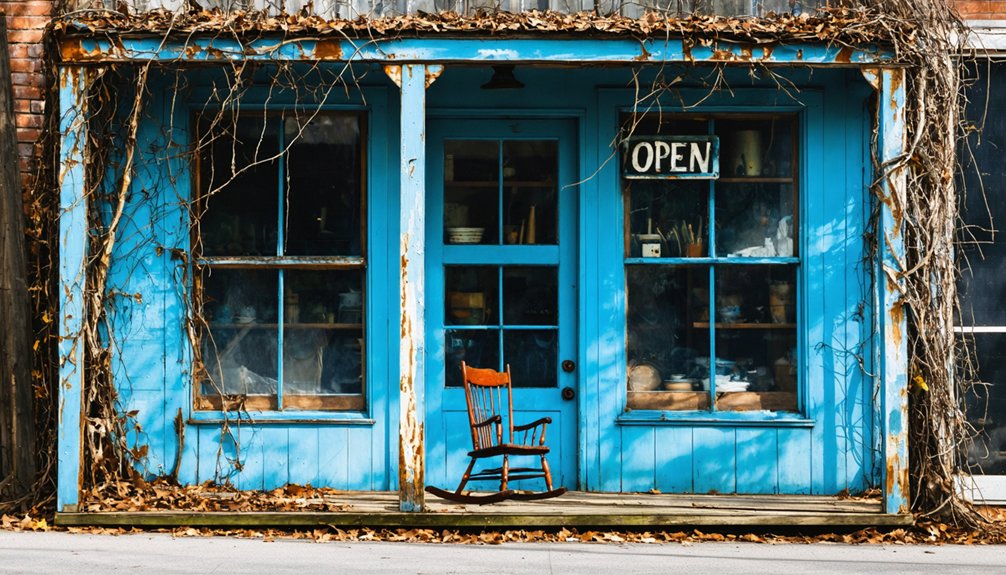You’ll find Dudleytown in northwestern Connecticut, a ghost town established in 1738 when Thomas Griffis acquired the land at a Yale College auction. The settlement peaked with 26 families by 1854 before declining due to poor farming conditions and economic hardship. Now protected by Dark Entry Forest, Inc., the abandoned village is notorious for alleged paranormal activity and the “Dudley Curse.” While historical records document the town’s struggles, its supernatural legacy continues to intrigue those seeking answers about its mysterious past.
Key Takeaways
- Dudleytown was a colonial settlement in Connecticut that was abandoned in the late 19th century due to economic hardship and poor farming conditions.
- The settlement peaked with 26 families in 1854 before residents left seeking better opportunities in the Midwest.
- The area is now protected by Dark Entry Forest Inc. and strictly prohibits public access due to trespassing and vandalism concerns.
- Supernatural legends claim the town was cursed, with reports of paranormal activity including shadowy figures and unexplained lights.
- Poor soil quality, challenging terrain, and the decline of local iron mining contributed to the settlement’s ultimate abandonment.
The Origins of Dudleytown Settlement
While Dudleytown was never officially recognized as a town, its settlement began when Thomas Griffis acquired half of the land at a Yale College auction in 1738, purchasing what was then known as the Mast Swamp area.
Though Griffis secured the property, he likely never lived there himself.
Despite owning the land that would become Dudleytown, Thomas Griffis remained an absentee landlord, never making it his home.
The settlement’s true foundation emerged in 1747 when Griffis sold a portion of the land to Gideon Dudley, marking the beginning of the Dudley family’s influence in the area.
You’ll find that Gideon wasn’t alone – his brothers Abiel and Barzillai, followed by Martin Dudley, joined him from England to establish their presence in this remote corner of Cornwall, Connecticut.
These early settlers gave the informal settlement its enduring name, though it remained just a nickname for this section of Cornwall.
The community grew steadily and reached its peak with 26 families by 1854.
Today, the area is protected by a land conservation group that maintains strict privacy over the historic grounds.
Legends and Tales of the Cursed Village
How did a remote Connecticut settlement become one of America’s most notorious haunted locations? The answer lies in the legendary Dudley Curse, which allegedly traveled from England with early settlers.
Though historians found no connection between local Dudleys and the executed nobleman Edmund Dudley, supernatural folklore flourished as residents experienced waves of misfortune.
You’ll find reports of shadowy figures emerging from forests, glowing apparitions, and visitors overwhelmed by feelings of evil. While some attribute the town’s troubles to poor soil and isolation, others point to Native American burial grounds and psychic impressions. The town’s population reached its peak with twenty-six families before declining due to hardships.
The community eventually shifted from farming to iron ore mining as residents sought new economic opportunities.
The legend gained national attention after Dan Aykroyd’s 1993 Playboy interview and “The Blair Witch Project” in 1999.
Today, despite being closed to the public, Dudleytown’s reputation as a cursed village continues to captivate paranormal enthusiasts.
Life in Early Colonial Dudleytown
Your mental picture of daily life should include families living in basic shelters, working the challenging terrain with iron mining eventually supplementing their meager farming income, all while dealing with the settlement’s remote location and difficult access to other communities.
The land was originally converted from forest to support the farming endeavors of early settlers, though the soil proved unsuitable for sustained agriculture.
You’ll find early colonial life in Dudleytown was marked by harsh subsistence farming, where settlers struggled against rocky soil and limited sunlight in their attempts to grow flax, wheat, and corn.
The iron industry helped the town briefly thrive during its peak years before eventual decline.
The isolated community, which never developed formal institutions like stores or churches, relied heavily on neighboring towns for supplies and services while peaking at just 26 families in 1854.
Daily Colonial Farming Life
Despite the early settlers’ hopes of establishing prosperous farms in Dudleytown, the harsh realities of colonial farming life quickly became apparent. You’d have found yourself battling rocky, infertile soil and a frustratingly short growing season in the shadowed valley. The dense wooded terrain made clearing land for agriculture an exhausting endeavor.
The farming struggles were so severe that you couldn’t rely on crops alone to sustain your family.
Community resilience emerged as settlers adapted to these challenges. You’d likely have joined your neighbors in sharing resources and knowledge while diversifying your income through iron mining and forging.
If you’d lived in Dudleytown then, you’d have worked alongside other families to transport goods through the difficult terrain of Dark Entry Forest, forming essential trade networks with nearby Cornwall to survive the harsh conditions.
Settler Living Conditions
Life in early colonial Dudleytown tested the limits of human endurance, with settlers facing harsh living conditions in their remote hilltop settlement. You’d have found yourself living in rustic homes built from local stone and wood, battling the elements on steep, rocky terrain.
The short growing season and poor soil made it tough to maintain a reliable food supply, while the isolated location meant limited access to basic necessities.
Your daily struggles would’ve included hauling water up the mountainous landscape and adapting to the harsh climate. The settler hardships were amplified by minimal infrastructure and the absence of modern conveniences. The swampy, marshy terrain made farming particularly challenging for residents. Many families experienced tragic deaths due to the unforgiving conditions.
You’d have relied entirely on what you could build, grow, or create from the challenging landscape around you. These demanding living conditions ultimately contributed to Dudleytown’s abandonment.
Community and Social Structure
While Dudleytown never achieved official town status, its close-knit community of about 26 families formed a distinctive social fabric centered around the prominent Dudley clan.
Family dynamics were heavily influenced by intermarriage within the settlement, as demonstrated when Martin Dudley wed Gideon’s daughter, creating tight bonds between residents.
You’d find that community interactions were shaped by the settlement’s isolation and limited infrastructure. Without their own church or school, residents had to journey to nearby towns for essential services.
The Dudleys, along with families like the Tanners, Joneses, Pattersons, Dibbles, and Porters, maintained strong social connections despite these challenges. Their shared experiences in farming the rocky terrain and working in iron production strengthened their communal bonds, even as they faced the hardships of their remote location. The need for accurate identification of the settlement became crucial as other Dudleytown place names existed during this period.
The Mysterious Decline and Exodus
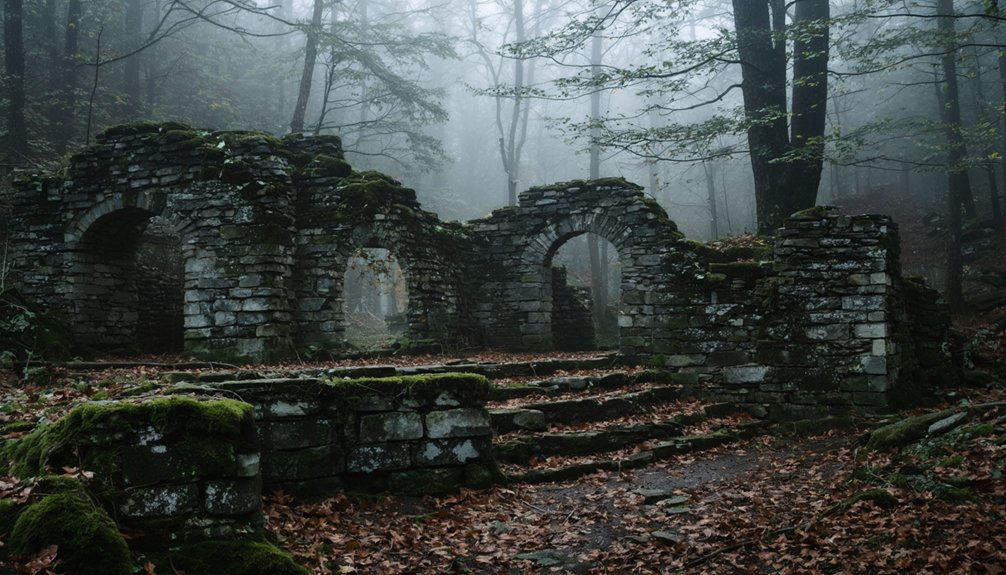
Throughout the late 19th century, Dudleytown’s once-thriving community began a steady descent into abandonment as multiple factors converged to seal its fate.
You’d have witnessed the mining industry’s westward shift creating widespread economic hardship, while the challenging terrain and poor soil quality made sustainable farming nearly impossible.
As more fertile lands opened in the Midwest, families sought better opportunities elsewhere, triggering steady population migration from the area.
Paranormal Activity and Unexplained Events
Since its abandonment in the late 19th century, Dudleytown has gained notoriety for alleged paranormal phenomena that continue to intrigue visitors and investigators.
If you venture into the surrounding woods, you’ll encounter reports of wispy apparitions, ghost sightings, and unexplained noises that echo through the trees. Visitors have documented mysterious lights and physical encounters, including claims of being touched or scratched by unseen forces.
The area’s paranormal reputation stems from its history as a Native American burial ground and the numerous tragedies that befell its settlers.
While some attribute these occurrences to supernatural forces and demonic activity, you’ll find that many investigators have captured what they believe to be paranormal evidence in photographs, though the site remains closed to protect against vandalism.
The Dark Entry Forest Today
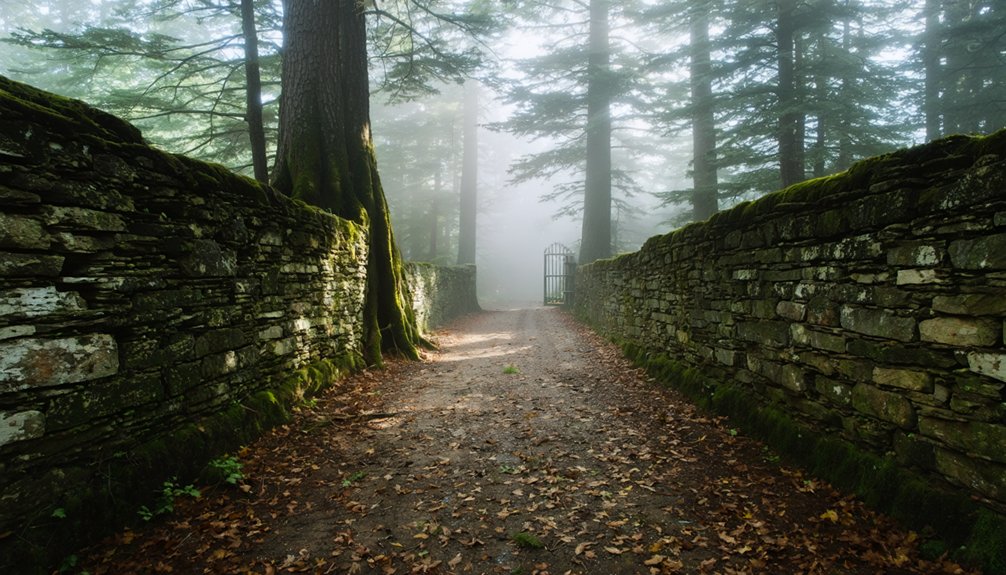
Today, Dark Entry Forest stands as a privately managed woodland under the protection of Dark Entry Forest, Inc., a corporation established in the 1920s by Dr. William Cogswell Clarke.
You’ll find the forest ecology has evolved considerably since Clarke’s initial reforestation efforts, which included planting thousands of red pine trees to restore abandoned farmland.
Under strict private ownership, you can’t freely explore the mature woodland’s rocky terrain and dense canopy. The forest harbors rare bird species, particularly saw-whet owls, but access requires special permits.
While former trails and dirt roads exist, they’re now largely overgrown and hazardous, with sinkholes and granite fractures beneath the surface.
The corporation’s no-trespassing policies, enforced through surveillance and police presence, have helped preserve the natural environment but have also reinforced the forest’s mysterious character.
Legacy and Impact on Local History
While you’ll find extensive folklore surrounding Dudleytown’s paranormal reputation, documenting its actual historical record presents significant challenges due to limited surviving primary sources and the area’s relatively brief period of settlement.
The village’s legacy lives on primarily through oral histories, paranormal investigations, and the continuing efforts of local historians to separate fact from fiction in Connecticut’s historical narrative.
You can trace Dudleytown’s lasting impact on local culture through its influence on regional identity, as demonstrated by the Dark Entry Forest Association’s ongoing preservation efforts and the community’s persistent fascination with the site’s mysterious past.
Historical Documentation Challenges
The historical documentation of Dudleytown presents significant challenges for researchers due to a scarcity of primary records and the pervasive influence of folklore on its narrative.
You’ll find that archival limitations severely restrict our understanding, with early land records only mentioning settler families like the Griffis and Dudleys without detailed context. Historical inaccuracies have multiplied as supernatural tales overshadow factual events.
The absence of an official cemetery within Dudleytown’s boundaries and the disappearance of original structures leave only cellar holes and foundations as physical evidence.
The site’s restricted access, coupled with vandalism from paranormal tourists, has further complicated research efforts. These challenges make it difficult to separate documented history from the mythological elements that have become deeply embedded in Dudleytown’s story.
Cultural Memory Preservation
Despite limited historical records, Dudleytown’s legacy endures through rich oral traditions and local folklore that have shaped Connecticut’s cultural landscape for generations.
These cultural narratives blend tales of supernatural occurrences with the real struggles of early American rural life, creating a complex tapestry of memory preservation.
You’ll find Dudleytown’s influence extends beyond local boundaries, impacting regional identity through its dual role as both a historical settlement and a symbolic ghost town.
While paranormal enthusiasts flock to the area, local museums and historians work to balance factual documentation with folkloric elements.
The site’s preservation as a private nature reserve helps protect not only the physical remains but also the layered cultural significance that continues to captivate both locals and visitors, despite restricted access.
Frequently Asked Questions
What Happened to the Original Structures and Buildings of Dudleytown?
You’ll find only cellar holes and scattered foundations of the abandoned architecture today, as time, neglect, and historical preservation efforts through private land trust ownership transformed original buildings into forest-covered ruins.
Are There Any Surviving Photographs of Dudleytown During Its Inhabited Period?
Like a missing puzzle piece in history, you won’t find surviving photographs from Dudleytown’s inhabited period. The historical significance remains undocumented through photographic evidence, with isolation and poor infrastructure limiting documentation.
What Legal Penalties Do Trespassers Face When Caught in Dudleytown?
You’ll face first-degree criminal trespass charges with up to $2,000 in fines and one year in jail. The legal consequences include court costs, probation, and a permanent criminal record.
Have Any Scientific Studies Been Conducted on Dudleytown’s Unusual Environmental Conditions?
Like a forest shrouded in mystery, you’ll find no formal scientific investigations of environmental anomalies in this location. Documented observations remain largely anecdotal, with no controlled studies measuring the reported phenomena.
How Many Documented Deaths Occurred in Dudleytown During Its Active Years?
You can’t find precise death records for historical significance, as no official mortality documentation exists. Local folklore claims many deaths, but these aren’t substantiated by any contemporary historical sources.
References
- https://newenglandhistoricalsociety.com/the-dudleytown-curse-connecticuts-village-of-the-damned/
- https://usghostadventures.com/haunted-stories/americas-most-haunted-east/the-curse-of-dudleytown/
- https://www.americanhauntingsink.com/dudleytown
- https://www.onlyinyourstate.com/experiences/connecticut/dudleytown-ct
- https://en.wikipedia.org/wiki/Dudleytown
- https://www.youtube.com/watch?v=t7SHpW0dc38
- https://www.youtube.com/watch?v=PKr-5HrudiI
- https://i95rock.com/mystery-of-dudleytown-ct/
- https://dailycampus.com/2016/10/05/2016-10-5-weird-wednesdays-connecticuts-cursed-town/
- http://cornwallhistoricalsociety.blogspot.com/2014/09/the-truth-about-dudleytown.html
